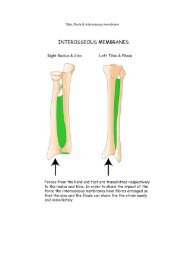GSM 11.11 version 6.2.0 - TTFN Smart card pages
GSM 11.11 version 6.2.0 - TTFN Smart card pages
GSM 11.11 version 6.2.0 - TTFN Smart card pages
- No tags were found...
You also want an ePaper? Increase the reach of your titles
YUMPU automatically turns print PDFs into web optimized ePapers that Google loves.
(<strong>GSM</strong> <strong>11.11</strong> <strong>version</strong> <strong>6.2.0</strong> Release 1997)34TS 100 977 V<strong>6.2.0</strong> (1999-05)8.20 FETCHThis function is used to transfer an Application Toolkit command from the SIM to the ME.Input:- none.Output:- data string containing an SIM Application Toolkit command for the ME.8.21 TERMINAL RESPONSEThis function is used to transfer from the ME to the SIM the response to a previously fetched SIM Application Toolkitcommand.Input:- data string containing the response.Output:- none.9 Description of the commandsThis clause states the general principles for mapping the functions described in clause 8 onto Application Protocol DataUnits which are used by the transmission protocol.9.1 Mapping principlesAn APDU can be a command APDU or a response APDU.A command APDU has the following general format:CLA INS P1 P2 P3 DataThe response APDU has the following general format:Data SW1 SW2An APDU is transported by the T=0 transmission protocol without any change. Other protocols might embed an APDUinto their own transport structure (ISO/IEC 7816-3 [26]).The bytes have the following meaning:- CLA is the class of instruction (ISO/IEC 7816-3 [26]), 'A0' is used in the <strong>GSM</strong> application;- INS is the instruction code (ISO/IEC 7816-3 [26]) as defined in this subclause for each command;- P1, P2, P3 are parameters for the instruction. They are specified in table 9. 'FF' is a valid value for P1, P2 and P3.P3 gives the length of the data element. P3='00' introduces a 256 byte data transfer from the SIM in an outgoingdata transfer command (response direction). In an ingoing data transfer command (command direction), P3='00'introduces no transfer of data.- SW1 and SW2 are the status words indicating the successful or unsuccessful outcome of the command.For some of the functions described in clause 8 it is necessary for T=0 to use a supplementary transport servicecommand (GET RESPONSE) to obtain the output data. For example, the SELECT function needs the following twocommands:- the first command (SELECT) has both parameters and data serving as input for the function;- the second command (GET RESPONSE) has a parameter indicating the length of the data to be returned.If the length of the response data is not known beforehand, then its correct length may be obtained by applying the firstcommand and interpreting the status words. SW1 shall be '9F' and SW2 shall give the total length of the data. Otherstatus words may be present in case of an error. The various cases are:ETSI








